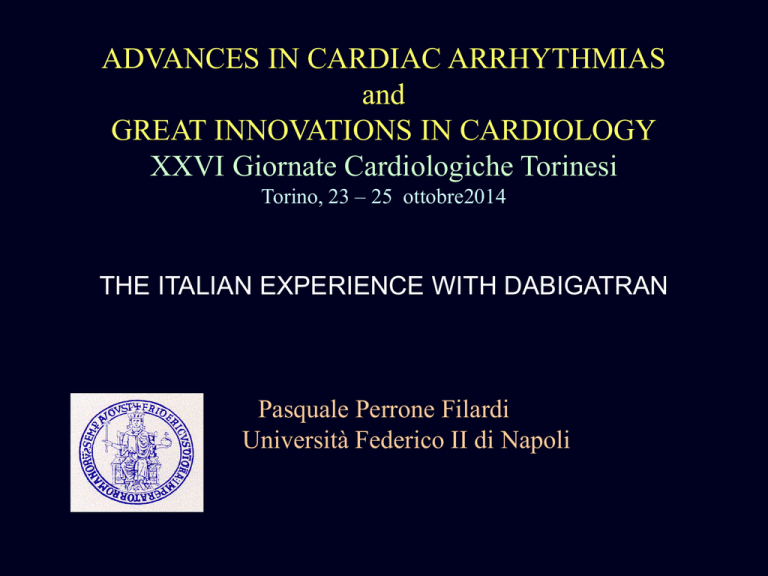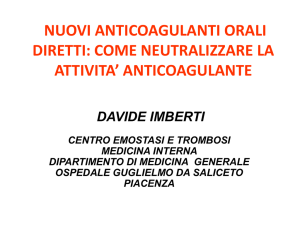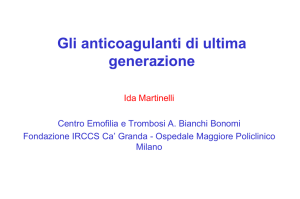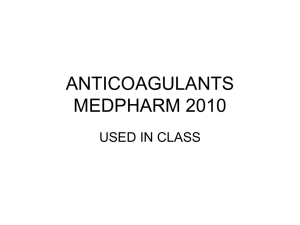
ADVANCES IN CARDIAC ARRHYTHMIAS
and
GREAT INNOVATIONS IN CARDIOLOGY
XXVI Giornate Cardiologiche Torinesi
Torino, 23 – 25 ottobre2014
THE ITALIAN EXPERIENCE WITH DABIGATRAN
Pasquale Perrone Filardi
Università Federico II di Napoli
Suddivisione dei pazienti in base al tipo di fibrillazione
atriale (FA) nei singoli paesi europei
G Ital Cardiol 2014;15(2):99-109
Distribuzione dei pazienti in base al punteggio CHA2DS2VASc: raffronto tra dati italiani ed europei (EU)
G Ital Cardiol 2014;15(2):99-109
Distribuzione delle classi di trattamento nei pazienti italiani
G Ital Cardiol 2014;15(2):99-109
Percentuale di pazienti con valori di INR adeguati, subottimali o instabili/alti
G Ital Cardiol 2014;15(2):99-109
Numero medio di monitoraggi dell’INR nell’ultimo mese
nei paesi europei (EU) partecipanti allo studio
G Ital Cardiol 2014;15(2):99-109
Main Outcome Measures
Larsen et al. JACC 2013;61:2264–73
Bleeding events among new starters and
switchers to dabigatran compared with
warfarin: an observational study among
patients with atrial fibrillation
Larsen TB et al.
Am J Med 2014;127:650–6.e5
doi: 10.1016/j.amjmed.2014.01.031
Observational study of bleeding risk in
patients with AF
Study period
2011
2012
2013
• Observational cohort study
• Nationwide Danish registries
• Patients with AF, stratified by prior
VKA use
• 11 315 first-time dabigatran users
(7063 VKA-naïve)
• 22 630 matched warfarin users
• VKA-naïve = ≥2 years since last
warfarin purchase
13 months of follow-up (mean)
Larsen TB et al. Am J Med 2014;127:650–6.e5. doi: 10.1016/j.amjmed.2014.01.031
D110 users were older, more often female, and at higher bleeding and
stroke risk than D150 users (VKA-naïve stratum: applying new-user
design [see slide 2])
Characteristic
VKA-naïve stratum
D110
D150
Warfarin
3045
4018
14 126
82 (77–86)
67 (62–72)
73 (66–80)
Age ≥65 yrs, %
95.3
63.6
76.8
Age ≥75 yrs, %
80.1
13.7
42.5
55.1
36.6
41.3
HAS-BLED score, mean (SD)
2.32 (1.04)
1.70 (1.11)
1.97 (1.18)
CHADS2 score, mean (SD)
1.91 (1.21)
0.94 (1.05)
1.33 (1.21)
CHA2DS2VASc score, mean (SD)
3.70 (1.47)
2.12 (1.41)
2.80 (1.67)
Patients, n
Median age (IQR), yrs
Female, %
D110 = dabigatran etexilate 110 mg BID; D150 = dabigatran etexilate 150 mg BID; IQR = interquartile range;
SD = standard deviation
Larsen TB et al. Am J Med 2014;127:650–6.e5. doi: 10.1016/j.amjmed.2014.01.031
Both dabigatran doses showed significant reductions in
risk of any bleeding vs warfarin* (VKA-naïve stratum)
VKA-naïve stratum
Hazard ratio (95% CI)
0.10
Dabigatran 110 mg
vs warfarin
Dabigatran 150 mg
vs warfarin
0.50 1.00 2.00
Adjusted HR†
5.00
Any
0.72 (0.59–0.88)
Major
0.93 (0.74–1.16)
Fatal
0.52 (0.28–0.95)
GI
0.50 (0.27–0.94)
ICH
0.30 (0.17–0.54)
Any
0.68 (0.55–0.84)
Major
0.67 (0.53–0.85)
Fatal
0.70 (0.33–1.52)
GI
1.45 (0.84–2.50)
ICH
0.33 (0.17–0.66)
Dabigatran better Dabigatran worse
*Adjusted HR; †Age, components of CHA2DS2-VASc, HAS-BLED, months since August 2011, time since initiation of VKA therapy
VKA = Vitamin K antagonist; Larsen TB et al. Am J Med 2014;127:650–6.e5. doi: 10.1016/j.amjmed.2014.01.031
Both dabigatran doses showed significant reductions in
risk of any bleeding vs warfarin* (VKA-naïve stratum)
VKA-naïve stratum
Hazard ratio (95% CI)
0.10
Dabigatran 110 mg
vs warfarin
Dabigatran 150 mg
vs warfarin
0.50 1.00 2.00
Adjusted HR†
5.00
Any
0.72 (0.59–0.88)
Major
0.93 (0.74–1.16)
Fatal
0.52 (0.28–0.95)
GI
0.50 (0.27–0.94)
ICH
0.30 (0.17–0.54)
Any
0.68 (0.55–0.84)
Major
0.67 (0.53–0.85)
Fatal
0.70 (0.33–1.52)
GI
1.45 (0.84–2.50)
ICH
0.33 (0.17–0.66)
Dabigatran better Dabigatran worse
*Adjusted HR; †Age, components of CHA2DS2-VASc, HAS-BLED, months since August 2011, time since initiation of VKA therapy
VKA = Vitamin K antagonist; Larsen TB et al. Am J Med 2014;127:650–6.e5. doi: 10.1016/j.amjmed.2014.01.031
Both dabigatran doses showed significant reductions in
risk of any bleeding vs warfarin* (VKA-naïve stratum)
VKA-naïve stratum
Hazard ratio (95% CI)
0.10
Dabigatran 110 mg
vs warfarin
Dabigatran 150 mg
vs warfarin
0.50 1.00 2.00
Adjusted HR†
5.00
Any
0.72 (0.59–0.88)
Major
0.93 (0.74–1.16)
Fatal
0.52 (0.28–0.95)
GI
0.50 (0.27–0.94)
ICH
0.30 (0.17–0.54)
Any
0.68 (0.55–0.84)
Major
0.67 (0.53–0.85)
Fatal
0.70 (0.33–1.52)
GI
1.45 (0.84–2.50)
ICH
0.33 (0.17–0.66)
Dabigatran better Dabigatran worse
*Adjusted HR; †Age, components of CHA2DS2-VASc, HAS-BLED, months since August 2011, time since initiation of VKA therapy
VKA = Vitamin K antagonist; Larsen TB et al. Am J Med 2014;127:650–6.e5. doi: 10.1016/j.amjmed.2014.01.031
Myocardial ischemic events in ‘real world’
patients with atrial fibrillation treated
with dabigatran or warfarin: a nationwide
cohort study
Larsen TB et al.
Am J Med 2014;127:329–36.e4
doi: 10.1016/j.amjmed.2013.12.005
Both dabigatran doses showed a non-significant trend to
lower MI rates vs warfarin* (VKA-naïve stratum)
VKA-naïve stratum
HR (95% CI)
Adjusted HR†
Dabigatran vs warfarin
0.10
0.50
1.00
2.00
5.00
MI D110
0.71 (0.47–1.07)
MI D150
0.93 (0.62–1.41)
Dabigatran better
Dabigatran worse
*Adjusted HR; †Age, components of CHA2DS2-VASc, HAS-BLED, history of any MI event, months since August 2011,
time since initiation of VKA therapy
Larsen TB et al. Am J Med 2014;127:329–36.e4. doi: 10.1016/j.amjmed.2013.12.005
Patologie concomitanti e fattori di rischio nei pazienti con
fibrillazione atriale nei diversi paesi europei
G Ital Cardiol 2014;15(2):99-109
Caratteristiche generali dei pazienti (n=204) in terapia con
Dabigatran etexilato (Pradaxa)
Eta' (anni; media±DS);
>80 anni
Sesso (maschi)
72 ±8
51
109
Scompenso cardiaco
85
Diabete mellito II
55
Pregresso Ictus cerebrale/TIA/ Episodio trombo-embolico
54
Ipertensione arteriosa
IM, malattia arteriosa periferica o placca aortica
Insufficienza renale cronica
Insufficienza epatica
Storia di sanguinamento o diatesi emorragica o anemia
Terapia concomitante con antiaggreganti piastrinici
con ASA o clopidogrel
con ASA e clopidogrel
Pazienti Naive
189
74
35
2
33
51
19
12
75
2,9±0,9
Pazienti già in TAO
129
1
2
3
16
46
83
INR instabile con tempo in range terapeutico < 60%
TTR (%; media±DS)
Pazienti in terapia con 220 mg/die
4
51
Pazienti in terapia con 300 mg/die
CHA2DS2VASc
(media±DS)
numero pazienti per
classe di rischio
HAS-BLED (media±DS)
numero pazienti per
classe di rischio
4,3±1,6
1
2
3
4
5
6
7
8
9
7
19
48
40
43
27
15
3
2
118
48±14
119
85
Caratteristiche generali dei pazienti (n=119) in terapia con
Dabigatran etexilato 220 mg/die (Pradaxa)
Eta' (anni; media±DS)
75 ±6
Sesso (maschi)
60(51%)
CHA2DS2VASc
(media±DS)
4,64±1,43
numero pazienti per
classe di rischio
HAS-BLED (media±DS)
numero pazienti per
classe di rischio
Scompenso cardiaco
48 (41%)
Diabete mellito II
31 (26%)
Pregresso Ictus cerebrale/TIA/ Episodio trombo-embolico
39 (33%)
IM, malattia arteriosa periferica o placca aortica
Insufficienza renale cronica
Insufficienza epatica
Storia di sanguinamento o diatesi emorragica o anemia
Terapia concomitante con antiaggreganti piastrinici
con ASA o clopidogrel
con ASA e clopidogrel
Pazienti Naive
111
(93%)
44(37%)
32(27%)
1 (0,1%)
22 (19%)
35 (29%)
14
11
51(43%)
3,1±0,91
Pazienti già in TAO
67 (56%)
1
2
3
4
INR instabile con tempo in range terapeutico < 60%
TTR (%; media±DS)
Effetti collaterali
Epigastralgia
68 (57%)
50±12
1(0,1%)
1
1
2
3
4
5
6
7
8
9
0
4
30
23
28
20
12
2
0
6
20
50
38
Ipertensione arteriosa
Caratteristiche generali dei pazienti (n=85) in terapia con
Dabigatran etexilato 300 mg/die (Pradaxa)
Eta' (anni; media±DS)
69 ±8
Scompenso cardiaco
37 (43%)
Sesso (maschi)
49 (57%)
Diabete mellito II
23 (27%)
CHA2DS2VASc
(media±DS)
3,8±1,80
Pregresso Ictus cerebrale/TIA/ Episodio trombo-embolico
16(13%)
Ipertensione arteriosa
IM, malattia arteriosa periferica o placca aortica
Insufficienza renale cronica
Insufficienza epatica
Storia di sanguinamento o diatesi emorragica o anemia
Terapia concomitante con antiaggreganti piastrinici
con ASA o clopidogrel
con ASA e clopidogrel
Pazienti Naive
78(66%)
30(25%)
3(0,3%)
1(0,1%)
11 (13%)
16(14%)
13
3
23(27%)
2,62±0,99
Pazienti già in TAO
62(72%)
1
2
3
4
INR instabile con tempo in range terapeutico < 60%
TTR (%; media±DS)
Effetti collaterali
Epigastralgia
50(60%)
46±15
1(0,1%)
1
numero pazienti per
classe di rischio
HAS-BLED (media±DS)
numero pazienti per
classe di rischio
1
2
3
4
5
6
7
8
9
7
15
18
17
15
7
3
1
2
10
26
33
13
Time to discontinuation by treatment group in
matched patients
A
B
1.00
1.00
Persistence probability
Persistence probability
Dabigatran
0.75
0.50
0.25
0
Warfarin
0.75
0.50
0.25
0
0
90
180
270
360
450
Time to discontinuation (days)
A) 30-day medication gap
Median persistence was longer for
dabigatran (389 days) than warfarin
(135 days) (P<0.001)
0
90
180
270
360
450
Time to discontinuation (days)
B) 60-day medication gap
Median persistence was longer for
dabigatran (>400 days) than
warfarin (222 days) (P<0.001)
Kaplan–Meier survival curves for propensity score-matched patients by treatment group
Zalesak M et al. Circ Cardiovasc Qual Outcomes 2013;6:567–74
Association between adherence (PDC) and outcomes
Am Heart J 2014 Jun;167(6):810-7
Mortality in relation to atrial fibrillation subtype
Eur Heart J 2014 Aug 31 doi:10.1093/eurheartj/ehu374
Risk of stroke, HF, AMI and GI bleeding in pts with AF
Piccini JP, Duke University, Eur Heart J 2014, 35: 250-6
REMARKS
• The vast majority of real world atrial fibrillation patients should be
anticoagulated according to Guidelines
• VKA therapy remains problematic in many patients
• Use of new oral anticoagulants is increasing but still suboptimal in Italy
• A substantial number of perceived contraindications to anticoagulation
therapy appear not justified
• Data from registries of NOA indicate and efficacy and safety profile even
more favorable than that observed in clinical trials
• However, despite stroke risk reduction, prognosis of AF is influenced by
comorbidities, mainly heart failure and CAD



